Five to Stay Alive
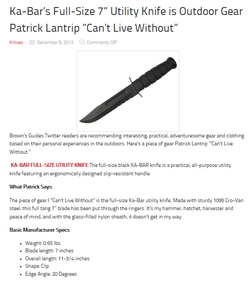 Via Brown's Guides
Via Brown's Guides Earlier this month, an outdoors website by the name of Brown’s Guides started a promotion titled: “Gear I Can’t Live Without.”
The website, whose mantra is “Great gear inspires great experiences,” asked its Twitter followers to briefly describe a piece of gear that they could not live without and explain why.
Since it has nearly 4,000 Twitter followers the responses were varied and numerous. Some described a favorite piece of clothing, or a small luxury item. Others interpreted it as an item vital to survival – meaning that if you only had one or two items in a survival
scenario, what would they be? I fell in the latter school of thought.
While a few of my suggestions did get used during the promotion, it inspired me to make a list of the five items that I would choose to have with me if I could only have five items in the wilderness. So I chose these items out of my gear bag to meet what I think are the most basic needs: water, food, shelter, protection and direction.
The website, whose mantra is “Great gear inspires great experiences,” asked its Twitter followers to briefly describe a piece of gear that they could not live without and explain why.
Since it has nearly 4,000 Twitter followers the responses were varied and numerous. Some described a favorite piece of clothing, or a small luxury item. Others interpreted it as an item vital to survival – meaning that if you only had one or two items in a survival
scenario, what would they be? I fell in the latter school of thought.
While a few of my suggestions did get used during the promotion, it inspired me to make a list of the five items that I would choose to have with me if I could only have five items in the wilderness. So I chose these items out of my gear bag to meet what I think are the most basic needs: water, food, shelter, protection and direction.

1. Ka-Bar Full Sized Utility Knife
Ka-Bar knives hit the jackpot when they received the contract to make the standard issue combat knifes for the U.S. Marines during WWII. Almost 75 years later, they still have the contract due to the suburb quality of their products. This knife can provide the peace of mind that is so crucial to any survival scenario, and can also be used as a hammer, hatchet or harvester of edibles.
Ka-Bar knives hit the jackpot when they received the contract to make the standard issue combat knifes for the U.S. Marines during WWII. Almost 75 years later, they still have the contract due to the suburb quality of their products. This knife can provide the peace of mind that is so crucial to any survival scenario, and can also be used as a hammer, hatchet or harvester of edibles.
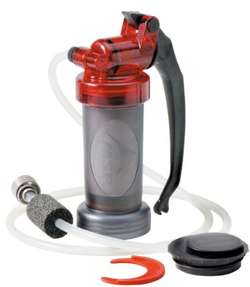
2. MSR Miniworks EX Microfilter
Clean, potable water is by far the most important resource in the wilderness. There are very few places in the world I would feel safe drinking untreated water from the source. In fact, Giardia and Cryptosporidium have found their way into almost every stream,
river, lake and pond in North America.
Normally, I prefer the old-fashioned boiling method, but I always have backups. In this scenario I feel like I would need a reliable, sturdy water filter that can provide me with fast, clean drinking water without wasting energy.
Clean, potable water is by far the most important resource in the wilderness. There are very few places in the world I would feel safe drinking untreated water from the source. In fact, Giardia and Cryptosporidium have found their way into almost every stream,
river, lake and pond in North America.
Normally, I prefer the old-fashioned boiling method, but I always have backups. In this scenario I feel like I would need a reliable, sturdy water filter that can provide me with fast, clean drinking water without wasting energy.
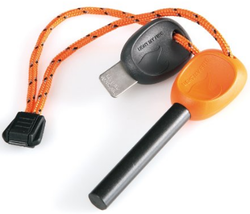
3. Firesteel 1,200 Strike Fire Starter
Aside from water and food, a good fire will do more for your psyche than anything else. Normally, I use my UCO waterproof matches, and adhere to the “one match, one fire” philosophy, but in a
survival scenario even “one match, one fire” will only get you so many fires. While it may be considerably harder to start a fire with one of these without practice, it can provide an indefinite number of fires while awaiting rescue.
Aside from water and food, a good fire will do more for your psyche than anything else. Normally, I use my UCO waterproof matches, and adhere to the “one match, one fire” philosophy, but in a
survival scenario even “one match, one fire” will only get you so many fires. While it may be considerably harder to start a fire with one of these without practice, it can provide an indefinite number of fires while awaiting rescue.
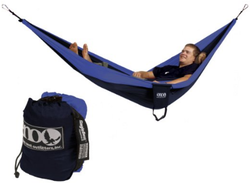
4. Eagle’s Nest Outfitters Hammock
I enjoy sleeping in this tent in the best of conditions, whether it be at home, at the park or on the trail, but in a survival scenario a light, comfortable shelter is invaluable. The normal setup of tent, sleeping bag, and pad only work when they are together. It would be hell to sleep on the ground without a pad and bag, and an
exposed sleeping bag is an open invitation to all sorts of unwanted nighttime visitors. This off-the-ground shelter can help get the good night sleep that is vital to keeping up one’s strength.
I enjoy sleeping in this tent in the best of conditions, whether it be at home, at the park or on the trail, but in a survival scenario a light, comfortable shelter is invaluable. The normal setup of tent, sleeping bag, and pad only work when they are together. It would be hell to sleep on the ground without a pad and bag, and an
exposed sleeping bag is an open invitation to all sorts of unwanted nighttime visitors. This off-the-ground shelter can help get the good night sleep that is vital to keeping up one’s strength.
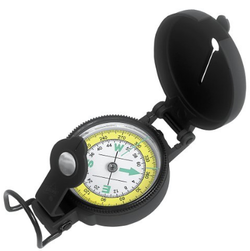
5. Silva Lensatic 360 Compass
It is not the fanciest compass in my gear bag, but it is the sturdiest. With a full pack, something that is compatible with a topo map would work much better. However, in this scenario I would consider a topo map another item. While it does have a sighting unit, it folds up compactly, and its aluminum body won’t smash if you drop it.
Well it may not be pretty, but I would like to think that I would be able to make it with just these five items. However, this is just my opinion, feel free to share your “Top Five to Survive” in the comment section. Special thanks to Brown’s Guides for the mentions, those interested in letting them know about any “Gear I Can’t Live Without” can contact them here.
It is not the fanciest compass in my gear bag, but it is the sturdiest. With a full pack, something that is compatible with a topo map would work much better. However, in this scenario I would consider a topo map another item. While it does have a sighting unit, it folds up compactly, and its aluminum body won’t smash if you drop it.
Well it may not be pretty, but I would like to think that I would be able to make it with just these five items. However, this is just my opinion, feel free to share your “Top Five to Survive” in the comment section. Special thanks to Brown’s Guides for the mentions, those interested in letting them know about any “Gear I Can’t Live Without” can contact them here.
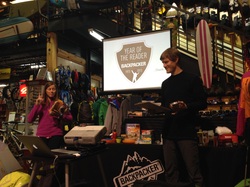
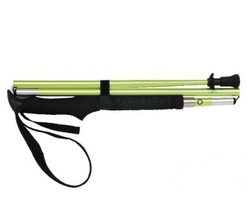
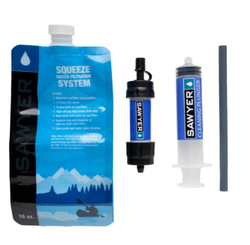
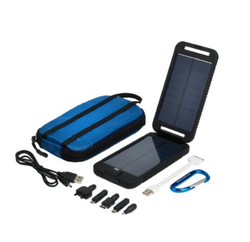
 RSS Feed
RSS Feed